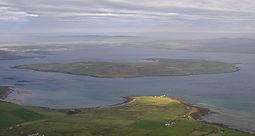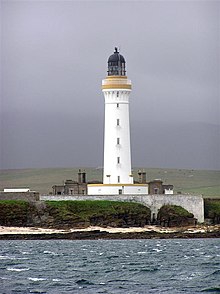Graemsay
| Norse name | Grímsey |
|---|---|
| Meaning of name | Grímr's Island |
 An aerial view of Graemsay, from above Hoy |
|
| Location | |
|
Graemsay shown within Orkney
|
|
| OS grid reference | HY255055 |
| Coordinates | 58°55′59″N 3°17′00″W / 58.933°N 3.2833°W |
| Physical geography | |
| Island group | Orkney Islands |
| Area | 409 ha (1.58 sq mi) |
| Area rank | 76 |
| Highest elevation | West Hill 62 m (203 ft) |
| Administration | |
| Sovereign state | United Kingdom |
| Country | Scotland |
| Council area | Orkney |
| Demographics | |
| Population | 28 |
| Population rank | 60 |
| Population density | 6.8 people/km2 |
| References | |

Hoy High Lighthouse in 2003
|
|
| Location | Graemsay Island Orkney Scotland United Kingdom |
|---|---|
| Coordinates | 58°56′08″N 3°16′24″W / 58.935665°N 3.273202°W |
| Year first constructed | 1851 |
| Automated | 1978 |
| Construction | stone tower |
| Tower shape | cylindrical tower with balcony and lantern |
| Markings / pattern | white tower, black lantern, ochre trim |
| Height | 33 metres (108 ft) |
| Focal height | 35 metres (115 ft) |
| Range | white: 20 nautical miles (37 km; 23 mi) red: 16 nautical miles (30 km; 18 mi) |
| Characteristic | Oc WR 8s. |
| Admiralty number | A3644 |
| NGA number | 3200 |
| ARLHS number | SCO-104 |
| Managing agent | Northern Lighthouse Board |
Graemsay is an island in the western approaches to Scapa Flow, in the Orkney Islands of Scotland. The island has two lighthouses.
Graemsay lies between Hoy and Stromness on Mainland Orkney, separated from the Mainland by Clestrain Sound. The island is 409 ha (1.58 sq mi) in area and is mainly crofted.
The island's geology is Old Red Sandstone of the Devonian period, with two volcanic faults. On the north coast there is granite-schist, a great rarity in Orkney.
Graemsay is surrounded by strong tidal races, known locally as roosts. An Orkney Ferries service, usually operated by MV Graemsay, links the island with Stromness and Moaness on Hoy.
Graemsay is sometimes referred to locally, as 'Orkney's green isle' due to its lush green vegetation cover.
Birds include oystercatchers, ringed plovers, redshank and curlew. Parts of the island are largely undeveloped and are a haven for wild plants.
As with many other Orkney Islands, there is a connection to the Celtic Church, possibly a pre-Norse one. There are the remains of two early churches, dedicated to St Bride and to St Columba., who are both saints of Irish origin.
The island has two lighthouses, Hoy High (NE) and Hoy Low (NW), both built in 1851 by Alan Stevenson for the 19th-century herring industry.
...
Wikipedia

